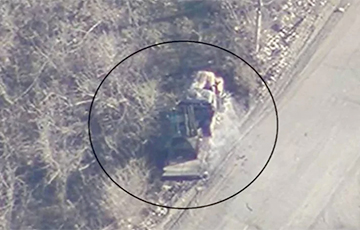FPV Destroys Russian ‘Frankenstein’ With Submarine-Attack Missiles Near Kharkiv
- 2.08.2024, 11:07
- 8,910

At first, it seemed that the Russians had rolled out a TOS-1 “Buratino” to the front line.
On or shortly before August 1, a drone operator from the Ukrainian army’s 3rd Assault Brigade, holding the line outside Kharkiv in northern Ukraine, spotted a rare target: what appeared to be a Russian TOS-1, a powerful thermobaric rocket launcher. OSINT analyst David Axe writes about this on the Forbes website.
It was only after the operator had steered their explosives-laden drone into the Russian vehicle, blowing it up, that Ukrainian observers realized the vehicle wasn’t a TOS-1 after all, but something far stranger — and rarer. It was a new kind of rocket vehicle combining the hull of an 1970s-vintage T-72B tank with an equally aged RBU-6000 launcher for naval anti-submarine rockets.
“A Frankenstein of a Russian tractor and naval missile launcher,” according to the 3rd Assault Brigade.
The RBU-6000-armed T-72B — the latest in a long line of improvised “Frankenvehicles” that have fought in Russia’s 29-month wider war on Ukraine — is further evidence of a growing problem for the Russians.
Strikes on the Russian T-72 tank chassis with an installed RBU-6000 anti-submarine missile launcher.https://t.co/0SW5pvAwqUhttps://t.co/RRE0Vn23lV https://t.co/p5LymbEEq4 pic.twitter.com/eTMdJrH1tj
— Special Kherson Cat 🐈🇺🇦 (@bayraktar_1love) August 1, 2024
As losses of purpose-made combat vehicles in Ukraine exceed 16,000, the Russian military is struggling to build, or recover from long-term storage, enough replacement vehicles. The Russian army went to war in Ukraine with around 50 TOS-1s, and has lost half of them.
A shortage of TOS-1s explains why Russia is apparently importing North Korean missile vehicles — and also why it’s bolting naval rocket launchers onto derelict T-72Bs, a thousand of which are sitting in open storage at facilities across Russia.
Although originally meant to sink submarines, the RBU-6000 isn’t a bad weapon for ground warfare. While inaccurate and thus unsuitable for precision strikes, it should work just fine for suppressing enemy troops.
The problem is range. A TOS-1 lobs two dozen 380-pound rockets as far as six miles. An RBU-6000 fires a dozen 250-pound rockets probably half that distance. The closer a launcher is to the front line, the more risk it faces from enemy fire.
That the Ukrainians have knocked out half of the Russians’ original TOS-1s underscores the danger. It’s not for no reason that, since first fielding ground-based RBU-6000s in Ukraine around a year ago, the Russians have been steadily up-armoring them—installing them first on thinly-protected MT-LB tractors and trucks, later on old T-80 tank hulls and finally on at least one T-72B.
Ukrainian forces destroyed one of the truck-mounted RBU-6000s back in April.
There’s only so much the Russians can do to add protection to their Frankenstein rocket launchers. A T-72B hull is more heavily protected than, say, a Ural truck. But an RBU-6000 is an RBU-6000, no matter what engineers attach it to. It’s a pack of 12 delicate rockets, each of which is almost certain to cook off when hit by an explosive drone, artillery fragments or even a few machine gun rounds.
According to the author of the publication, the front line of the Russia-Ukraine war is the most dangerous landscape in the world — a 700-mile ribbon of trenches and craters, seeded with mines and buzzing with drones, that in less than three years has consumed tens of thousands of vehicles and hundreds of thousands of people.
No short-range rocket launcher — neither a purpose-made TOS-1 nor an improvised T-72B-RBU-6000 — is safe on that terrain. And that 3rd Assault Brigade drone operator proved it.











